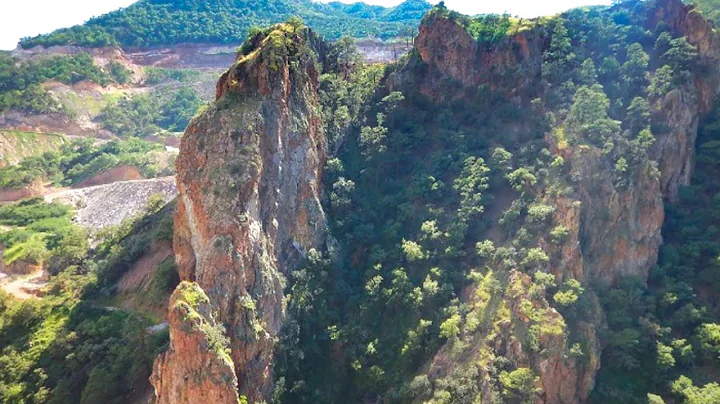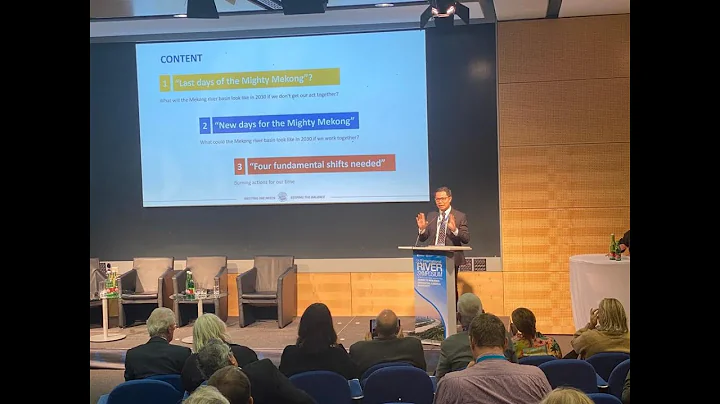The Gansu Provincial Party Committee launched the Tao River Diversion Project in order to solve the survival problems of drought, lack of rain, sparse vegetation, and abnormal barrenness in Dingxi, Pingliang and other areas.
This project is called a "model water conservancy project" and is known as " Galaxy falls into the world" and "Alpine Canal". When construction started in June 1958, it was promoted as "a communist project, an initiative of the heroic people." However, this project lasted more than three years and cost hundreds of thousands of people, but it ended in disgrace.

The Tao River is an upstream tributary of the Yellow River . It originates from the eastern foothills of Xiqing Mountain in the west of Luqu County, Gansu Province, and flows through Luqu, Xiahe, Zhuoni, Lintan, Weiyuan, Lintao, Yongjing and other counties in Gansu Province. , with a total length of 673.1 kilometers, a drainage area of 25,527 square kilometers, and an average annual runoff of 5.3 billion cubic meters, the river is very rich in water resources.
In the winter of 1957, the second meeting of the Second Gansu Provincial Congress was held in Lanzhou. After formulating a comprehensive plan of "three years of hard work to basically change the face of the province" and "six years to achieve the forty principles of agriculture". During the meeting, someone proposed starting from the Tao River in the south to solve the drought problem in eastern Gansu by "diversion from the Tao River to the Wei River". With the support of the Provincial Party Committee, the Water Conservancy Bureau, the First Design Institute of the Ministry of Railways, the Northwest Water Conservancy Survey and Design Institute, and Dingxi The Agricultural Construction Bureau and other units jointly sent staff to conduct on-site inspections. However, before the survey team returned, the provincial party committee decided to implement the diversion project at the end of the meeting in February 1958.
In March 1958, the surveyors proposed the prototype of the Tao diversion project, which was to divert water from Longwangtai of Min County, along the left bank of the Tao River through Meichuan of Min County , and Zhongzhai of Huichuan to Jingyuan Xinbaozichuan, Changchun It reaches 760 kilometers, including the diversion from Moon Mountain to Dongzhiyuan, which is about 350 kilometers long, making a total length of 1,100 kilometers. This line almost spans the entire eastern Gansu, and its difficulty can be imagined just from the planning. People at that time had realized that the areas the channel passed through were all in the Loess Plateau. The alpine soil particles were sparse, contained salt and alkali , and had large gaps. Once water flow eroded, it would easily leak and easily cause the bottom of the channel to collapse and sink. This was a critical issue. There is no effective solution in the world for soil quality problems related to the quality of the canal. The canal passes through many tall watersheds and needs to pass through many large and complex water tunnels. Both the technical and financial requirements were completely beyond the affordability at the time.
The Tao Diversion Project plans to divert 3 billion square meters of water, flowing through more than Longzhong more than 10 counties and cities, and irrigating more than 7 million acres of land. "An increase of 300 kilograms per mu can increase the production of 2.1 billion kilograms of grain." This huge The temptation caused the Gansu government to shout slogans such as "As long as the Tao River can be brought up the mountain, we can have whatever we want" and "If water can't flow up the mountain, you won't get married."
However, the adoption of the tripartite policy of "measurement, design, and construction" and the hasty diversion project that was launched before the survey was completed created hidden dangers of failure from the very beginning. It is required to take three or even two years. The construction policy of "private government assistance and local materials" means that state investment is supplemented and people's support is the mainstay. The labor, funds, food, and materials required for the project far exceed the provincial party committee. It was initially expected that as the project continued and became more difficult, the materials needed for the construction site would far exceed the affordability of the people. Even the number of acres of irrigated farmland ultimately generated by the project is just the result of simply asking the administrative leaders of the areas where the channel passes through the area of cultivated land within their jurisdiction. There is no survey and determination of the specific flow direction of the channel and the actual situation of the area where the channel flows. The degree of sloppiness is visible. A spot. Not long after the
project started, numerous migrant workers began to think about leaving due to various practical difficulties: very little vegetable
supply, lack of salt, no houses, and they could only live in damp cave dwellings. Due to lack of fuel, there was very little boiling water supply, and they could not even cook. Hot kang, the road at the construction site is impassable, so we can only rely on manpower to carry food up the mountain. There are no mechanized construction tools, so we can only rely on manpower to carry it on our shoulders. The working hours are long, "the sun cannot be seen from both ends", and "night battles" are often engaged in. Under such difficult conditions, when building a "mountain canal" on a mountain more than 1,000 meters above sea level, one can imagine the resistance and doubts encountered. The migrant workers' sabotage and escape have never stopped.According to statistics, more than 9,000 people fled in the first half year of construction, about 1,000 people were repatriated to the construction site, more than 4,000 people ran back to their hometowns, more than 2,000 people worked in cities such as Lanzhou, Baiyin, and Yumen, and nearly 1,000 people fled to Qinghai, Xinjiang and other provinces. About 900 people are still missing in search of a living. In mid-March 1959, 169,000 migrant workers arrived at the Tao construction site, and by the beginning of July, more than 20,000 had fled.
The head of the Tao River Diversion Project is located in Gucheng Village, Min County. The Gucheng Reservoir was built here to raise the water level of the Tao River so that it can pass through the repaired diversion channel and flow to the designed channel. Therefore, whether it is completed or not is closely related to the entire project. In August 1958, the Diversion Engineering Bureau proposed the "Key Points for Planning and Design of the Gucheng Reservoir (Draft)", and construction officially started on September 1, with 20,000 migrant workers working here. On April 8, 1959, the Gucheng Reservoir implemented a forced closure, and the cofferdam was closed on the 14th. However, the diversion channel project has not yet been excavated to the designed cross-section, resulting in insufficient diversion capacity. In addition, the fierce water flow of the Tao River destroyed the breach and failed to intercept the flow, resulting in the loss of wheat straw .8 million kilograms, 7.5 tons of lead wire, and 3.5 tons of hemp rope. tons etc. On July 1, the Gucheng Reservoir was closed again. However, a sudden heavy rain on August 11 caused the water level of the Tao River to rise sharply. It burst again on the 12th, causing heavy losses. About 1,500 square meters of wood, more than 70 tons of explosives, more than 17,000 kilograms of grain, and other materials worth about 380,000 yuan were washed away. Three migrant workers died while rescuing supplies, 1,300 houses and 3,800 acres of farmland were destroyed, and more than 20,000 residents in 4,000 households were affected. Another breach of the Gucheng Reservoir interrupted the "July 1" plan to open Dayingliang to water, seriously affecting the mood of migrant workers, and the phenomenon of escape became more serious. The first team of Tianshui Work District escaped 39 people in one night.
On July 15, 1959, Gansu Province reported to the central government: "The population in areas with serious food shortages is 1.54 million. These areas generally cannot eat half a catty of food. There are more than 96,000 people suffering from edema in the province. According to preliminary statistics, due to food shortage and edema More than 2,200 people have died from the disease, and more than 60,000 people have flown into neighboring provinces abnormally, and more than 10,000 people have moved from county to county within the province. Production in some places has come to a standstill. "However, the situation changed sharply after the Lushan Conference. The Gansu cadres who submitted this report were labeled as a "right opportunist anti-party group", and the situation became "good" again. At that time, due to the periodic shortage of food and non-staple food, edema and death occurred in individual work sections. After careful investigation, the deputy director of the Health Department of the Engineering Bureau believed that it was caused by nutritional deficiencies. However, such remarks were immediately regarded as "right-leaning remarks", and the Department of Health criticized the so-called " bourgeois subjectivist erroneous views". The "anti-rightist" movement has put everyone in danger. Migrant workers cannot even say something like "I don't have enough to eat and the work is too heavy." Once they are heard, they will be criticized and fought.
However, as the disaster further intensified, 5.1 million people in Gansu Province had daily rations of less than 7 taels (16 taels), of which about 800,000 could only eat 2 taels a day. Gansu's hunger and population exodus had reached an uncontrollable point, and the final project was officially announced on March 8, 1962.
The Tao diversion project lasted more than three years. During this period, the state invested 150 million yuan, spent more than 60 million man-days of labor, and immeasurable amounts of cement, steel and wood. In addition, 2,418 people died and 400 people were disabled. A large number of laborers were invested in the construction of the Tao diversion project, which squeezed out the food rations of the people in the beneficiary areas that provided food, aggravated the excessive consumption of food, and destroyed the normal order of agricultural production in the relevant areas. Due to the strong "communist trend", the material and financial resources of the people in the drought-stricken plateau were allocated to the project for free. When the project was terminated, a total of 43.14 million yuan was estimated to have been flattened. A large number of original trees along the Tao River have been cut down in large numbers under the "local use" policy to make wooden tools, cook, and heat, which has greatly damaged the local ecological environment. High mountain cliffs, the rolling Tao River, and explosives, ropes, and hand tools manufactured using simple processes have increased the risks of construction. The transformation brought about by political movements, the number of disaster fighters being beaten and committing suicide has increased sharply, and the rudimentary medical and health conditions As a result, it is difficult for the sick and wounded to receive effective treatment, and there are also cases of edema and even death caused by a periodic lack of food and non-staple food. In addition, it is difficult for disabled migrant workers to receive effective compensation for the aftermath. For example, Yuzhong County 10,000 migrant workers went to the Yintao construction site one after another, and "300 people died due to work," but "the pension situation has not been tested."




















![[Countryhumans] niko niko ni - DayDayNews](https://i.ytimg.com/vi/ELGe6GF_AiY/hq720_2.jpg?sqp=-oaymwE2CNAFEJQDSFXyq4qpAygIARUAAIhCGABwAcABBvABAfgBzgWAAoAKigIMCAAQARhlIFsoZTAP&rs=AOn4CLCa1gMnMsNysAnm3_OwWkyR2XLh5Q)
